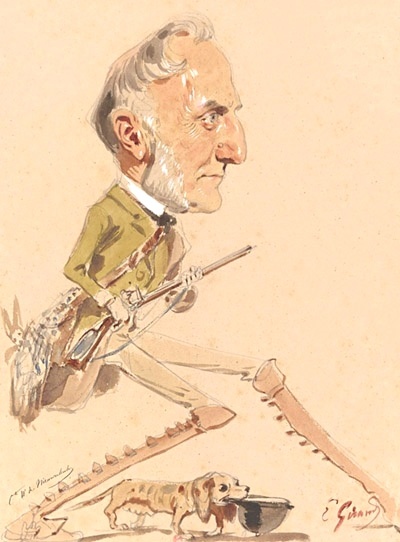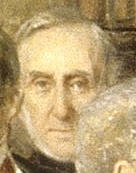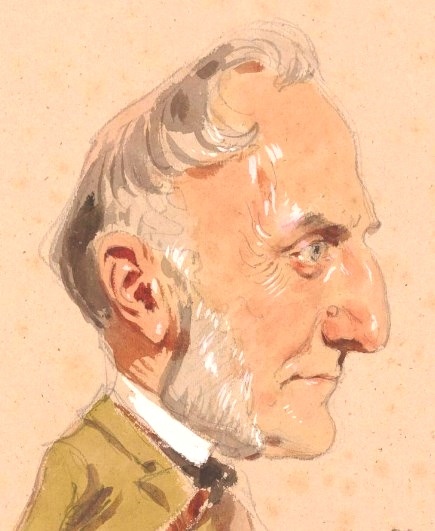Guillaume de Nieuwerkerke (1785-1864), count, cavalery officer (uncle of Émilien)
1st image: Soirée; 2nd: caricature by Giraud (c. March 1855).

An ardent game hunter, Guillaume de Nieuwerkerke (caricatured by Giraud holding a hunting rifle) was a familiar figure at the royal court and naturally found his way into Soirée au Louvre —though placed in the background—under the identity of “the uncle of.” Since Soirée au Louvre was supposed to serve as a testament to the importance of Count Émilien de Nieuwerkerke16, Émilien ensured that his uncle Guillaume and his father, Charles71, were included, sharing in the prestige.
His passion for hunting makes it likely that Guillaume attended the vendredi-soirée in 1854 when Gérard32 lectured on his experiences hunting lions in Africa.Not being a musician or artist, Guillaume’s presence was never recorded in cultural journals, but Viel-Castel mentions, and dines with him, several times. While Émilien de Nieuwerkerke certainly wished to immortalize his uncle and father in this significant artwork, he did not publicize their inclusion in the press.
Guillaume, also known as William, de Nieuwerkerke, was the eldest son of Willem Hendrik van Nieuwkerk. His father, an illegitimate son of Stadtholder William IV of Orange, was born in The Hague in 1750 and later served as consul in Morocco. He married Marie Françoise Émilie de Roubaud from Marseille.
The family initially settled in Lyon, where Guillaume and Charles (Émilien’s father) were born, before moving to Paris, where their sister Blanche (1799 - 1829) was born.
Guillaume studied at the École Polytechnique, married Lady Didelot de la Torte and became head of the Royal Guard. He gained local renown when, in 1815, he rode into Paris on horseback alongside his brother Charles, the Marquis de Pons, and Baron Armand de Maistre, publicly demonstrating his royalist loyalties following the end of Napoleon I’s Cent Jours (Hundred Days) reign.
In recognition of his service, he was awarded the rank of Chevalier in the Légion d’Honneur as Grenadier au Cheval in 1817.

